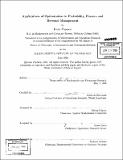Applications of optimization in probability, finance and revenue management
Author(s)
Popescu, Ioana
DownloadFull printable version (9.032Mb)
Other Contributors
Massachusetts Institute of Technology. Operations Research Center.
Advisor
Dimitris Bertsimas.
Terms of use
Metadata
Show full item recordAbstract
The unifying contribution of this thesis is to show that optimization is a very powerful tool that provides unexpected insights and impact on a variety of domains, such as probability, finance and revenue management. The thesis has two parts: In the first part, we use optimization models and techniques to derive optimal bounds for moment type problems in probability and finance. In the probability framework , we derive optimal inequalities for P(X E S), for a multivariate random variable X that has a given collection of moments, and an arbitrary set S. We provide a complete characterization of the problem of finding optimal bounds, from a complexity standpoint. We propose an efficient algorithm to compute tight bounds when S is a union of a polynomial number of convex sets, and up to second order moments of X are known. We show that it is NP-hard to obtain such bounds if the domain of X is Rn+, or if moments of third or higher order are given. Using convex optimization methods, we prove explicit tight bounds that generalize the classical Markov and Chebyshev inequalities, when the set S is convex. We examine implications to the law of large numbers, and the central limit theorem. In the finance framework, we investigate the applicability of such moment methods to obtain optimal bounds on financial quantities, when information about related instruments is available. We investigate the relation of option and stock prices just based on the no-arbitrage assumption, without assuming any model for the underlying price dynamics. We introduce convex optimization methods, duality and complexity theory to shed new light to this relation. We propose efficient algorithms for finding best possible bounds on option prices on multiple assets, based on the mean and variance of the underlying asset prices and their correlations and identify cases under which the derivation of such bounds is NP-hard. Conversely, given observable option prices, we provide best possible bounds on the moments of the underlying assets as well as prices of other options on the same asset. Our methods naturally extend for the case of transactions costs. The second part of this thesis applies dynamic and linear optimization methods to network revenue management applications. We investigate dynamic policies for allocating inventory to correlated, stochastic demand for multiple classes, in a network environment so as to maximize total expected revenues. We design a new efficient algorithm, based on approximate dynamic programming that provides structural insights into the optimal policy by using adaptive, non-additive bid-prices from a linear programming relaxation. Under mild restrictions on the demand process, our algorithm is asymptotically optimal as the number of periods in the time horizon increases, capacities being held fixed. In contrast, we prove that this is not true for additive bid-price mechanisms. We provide computational results that give insight into the performance of these algorithms, for several networks and demand scenarios. We extend these algorithms to handle cancellations and no-shows by incorporating overbooking decisions in the underlying mathematical programming formulation.
Description
Thesis (Ph.D.)--Massachusetts Institute of Technology, Dept. of Mathematics; and, (Ph.D.)--Massachusetts Institute of Technology, Operations Research Center, 1999. Includes bibliographical references (p. 144-151).
Date issued
1999Department
Massachusetts Institute of Technology. Department of Mathematics; Massachusetts Institute of Technology. Operations Research CenterPublisher
Massachusetts Institute of Technology
Keywords
Mathematics., Operations Research Center.